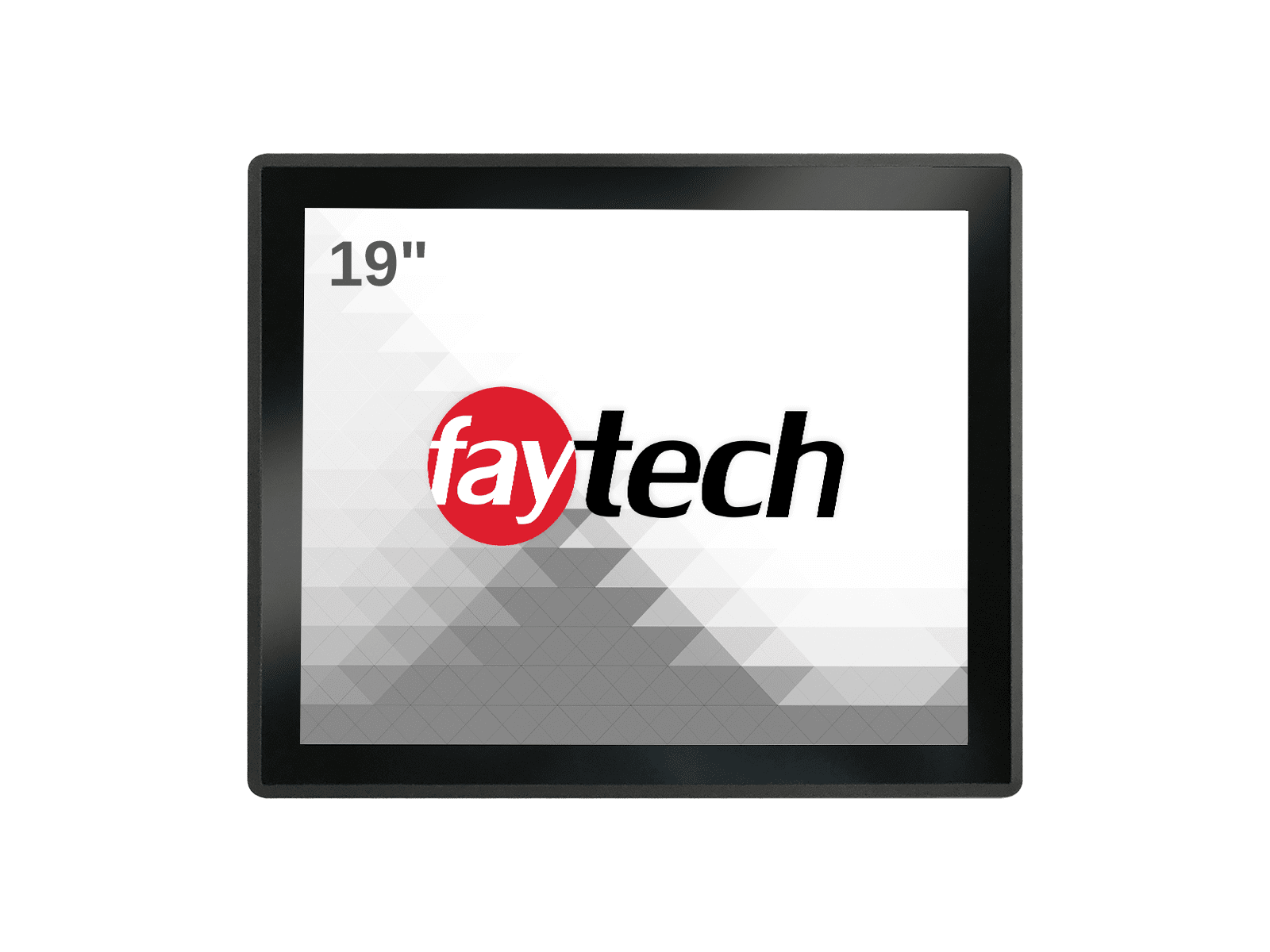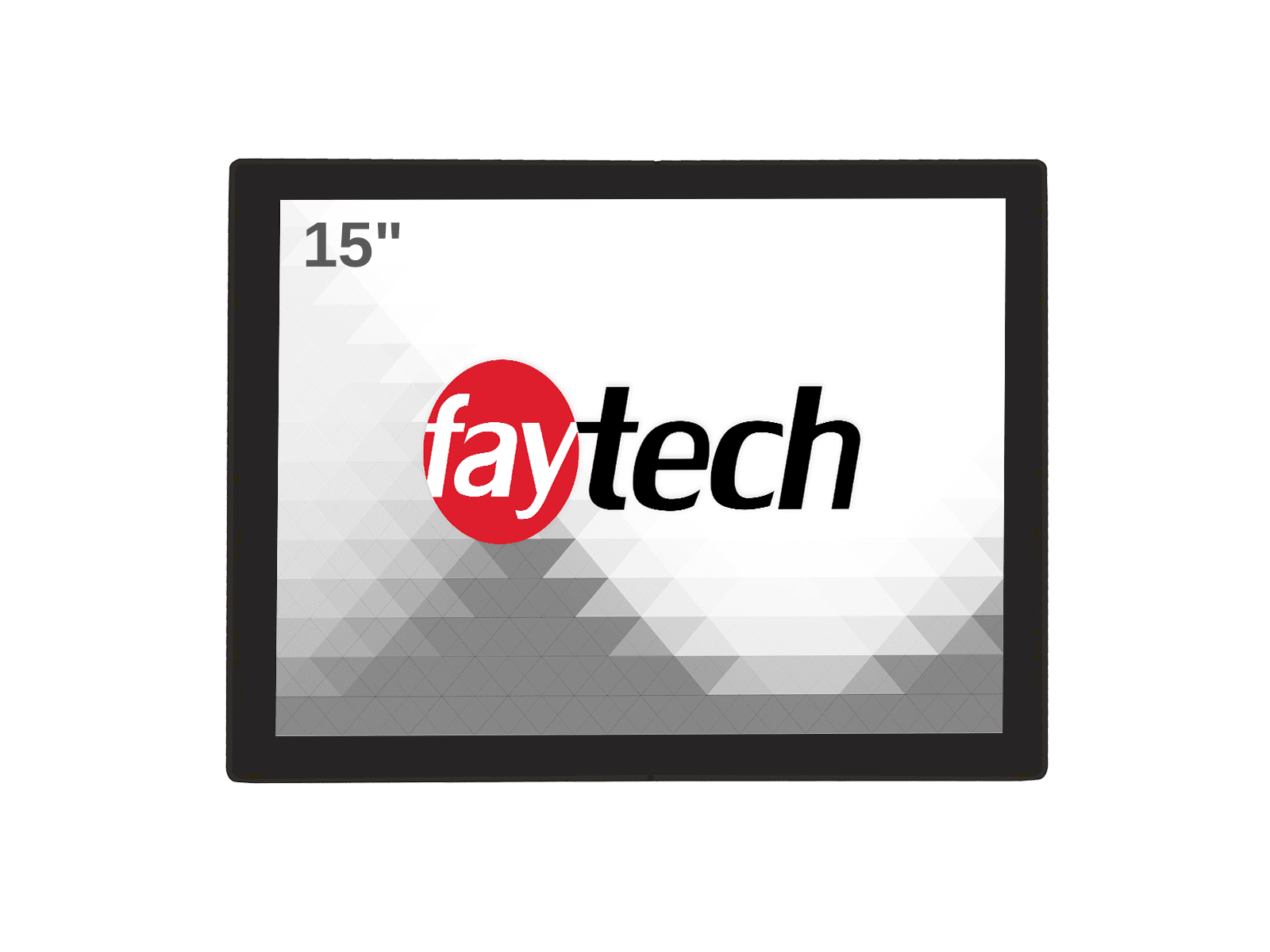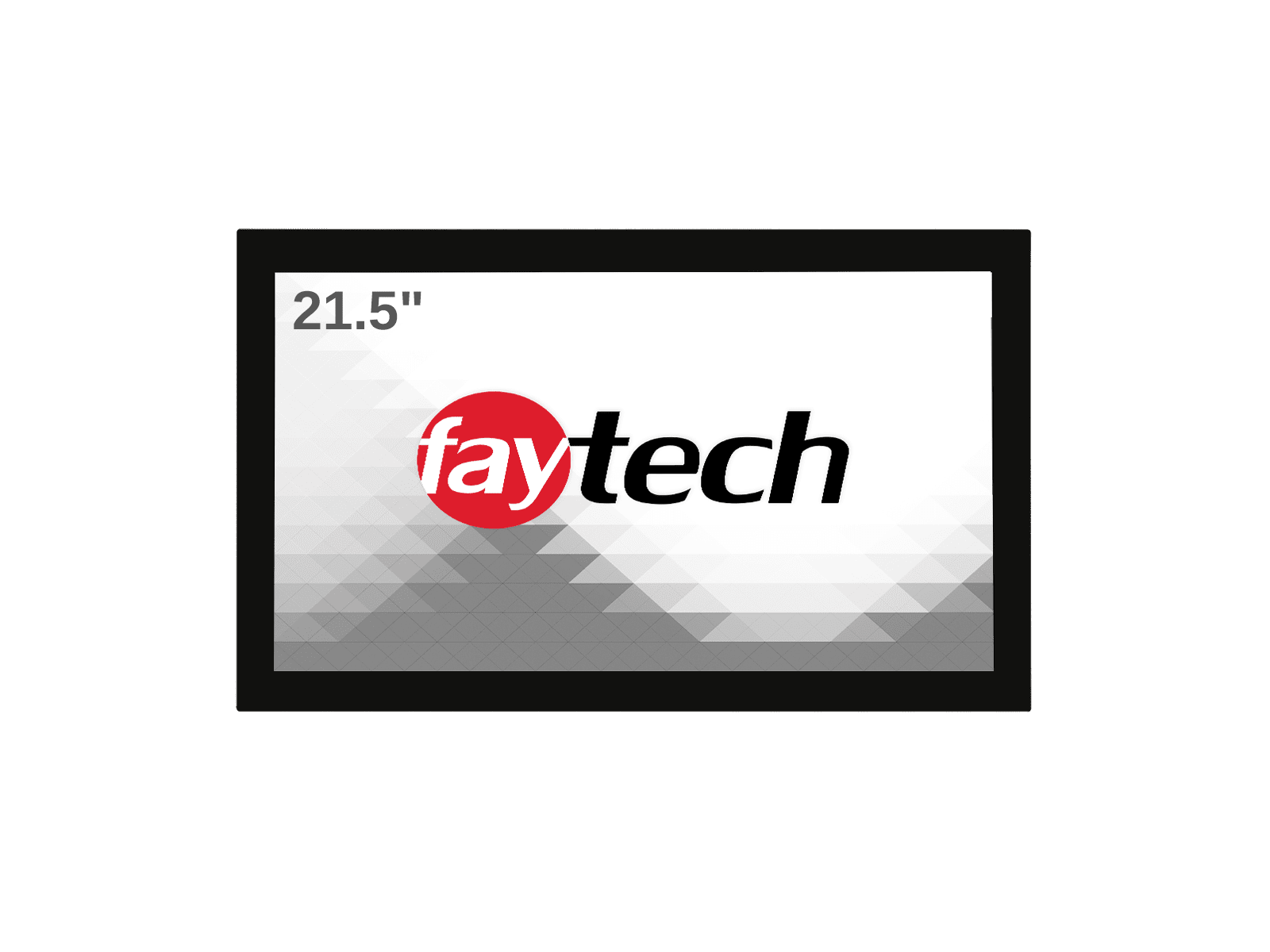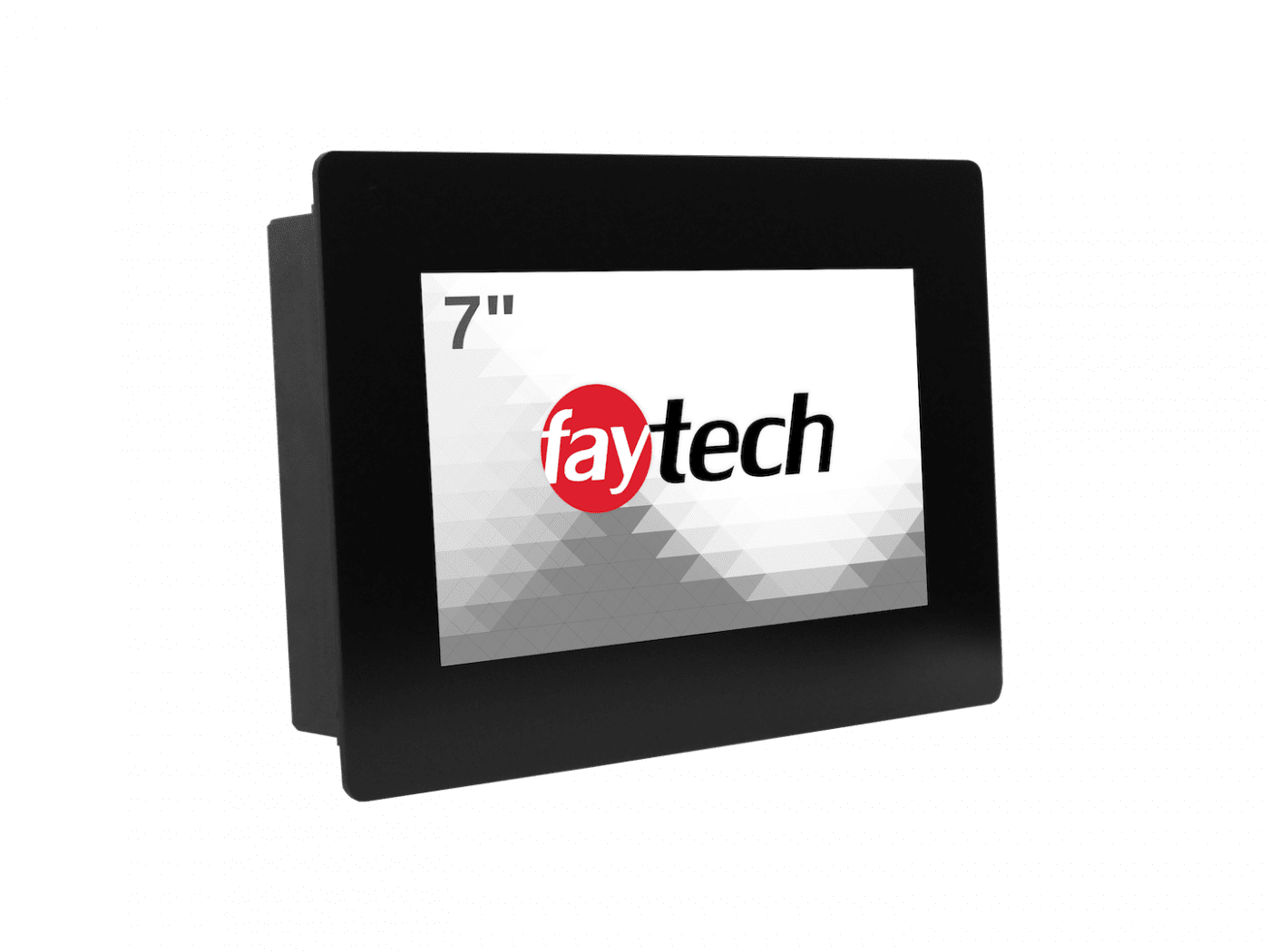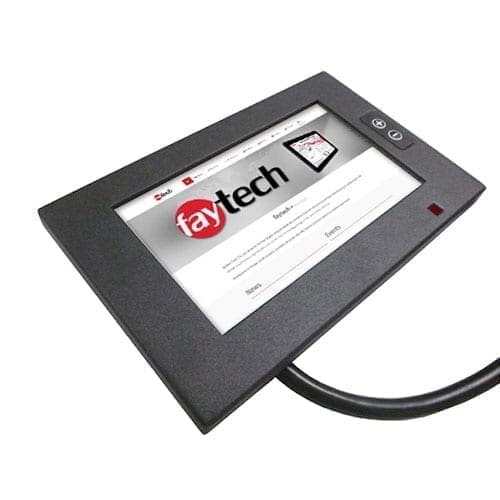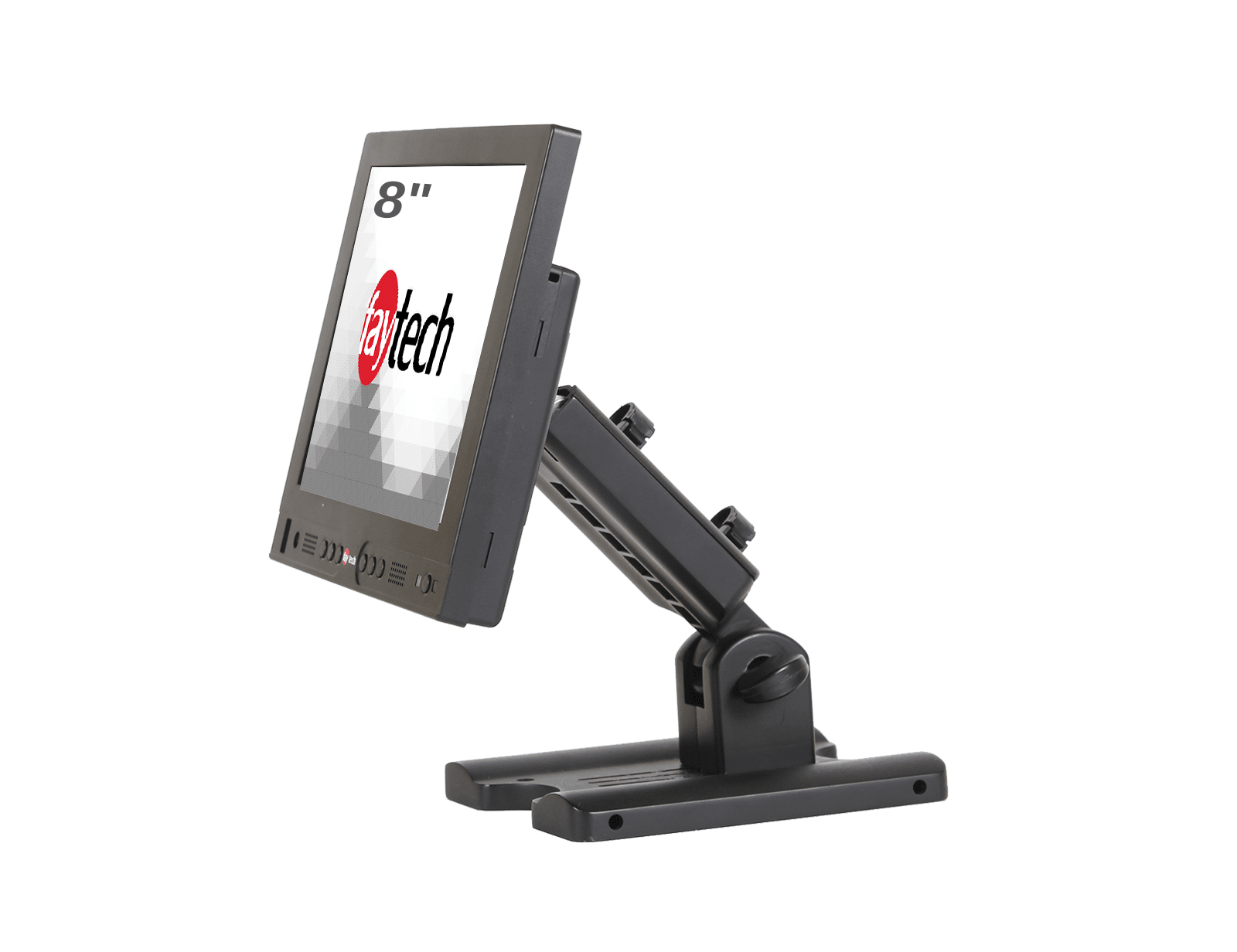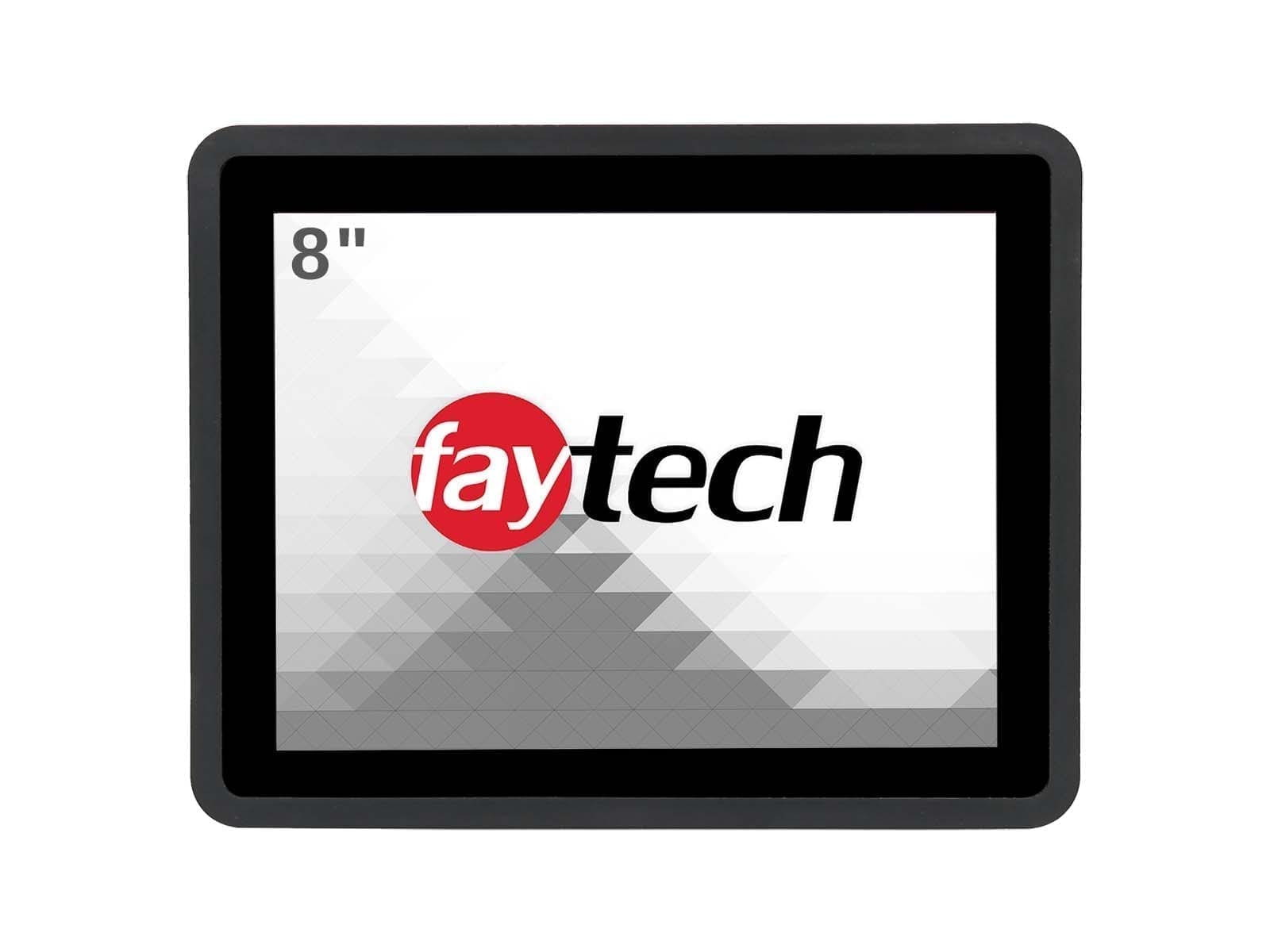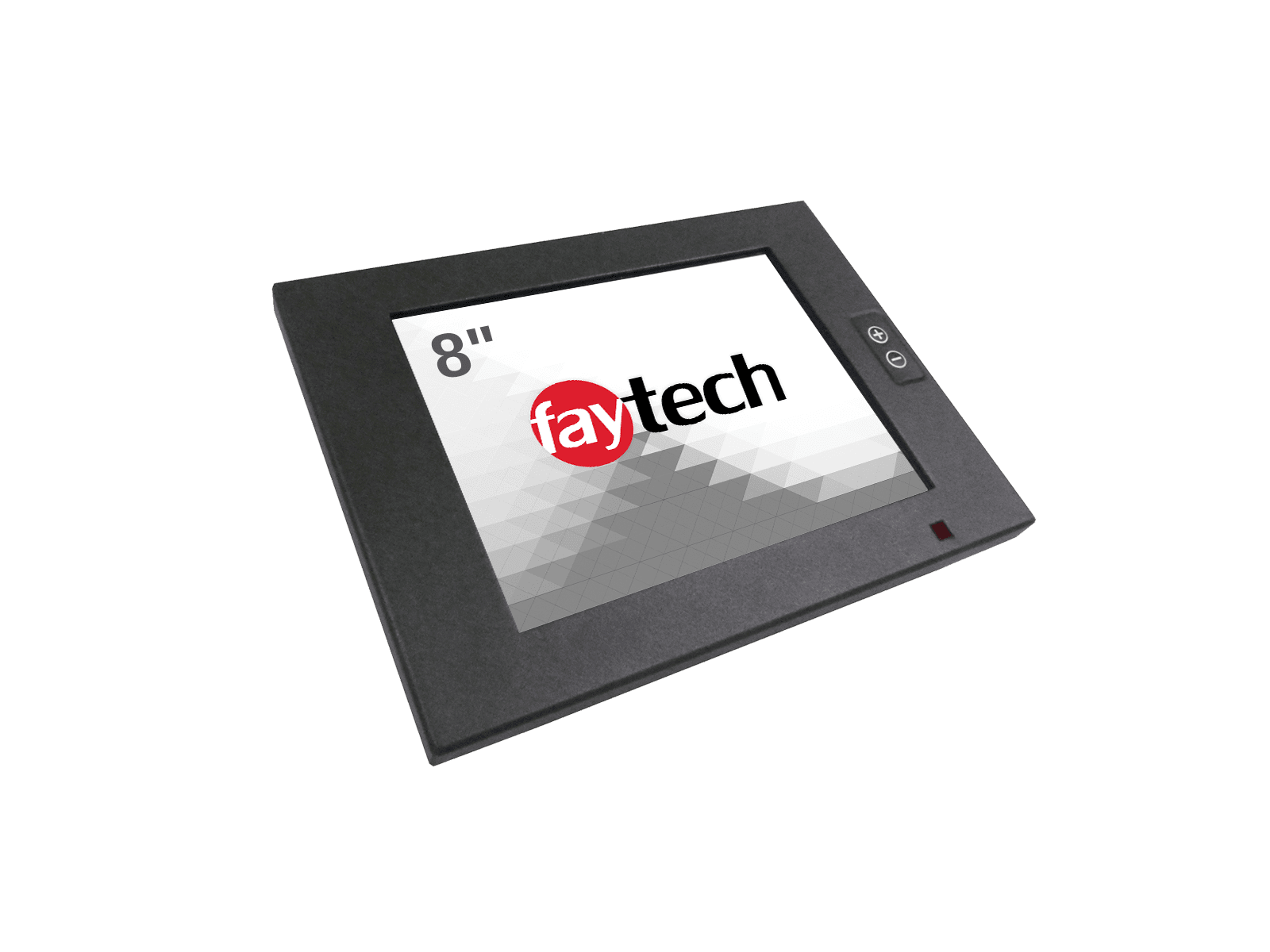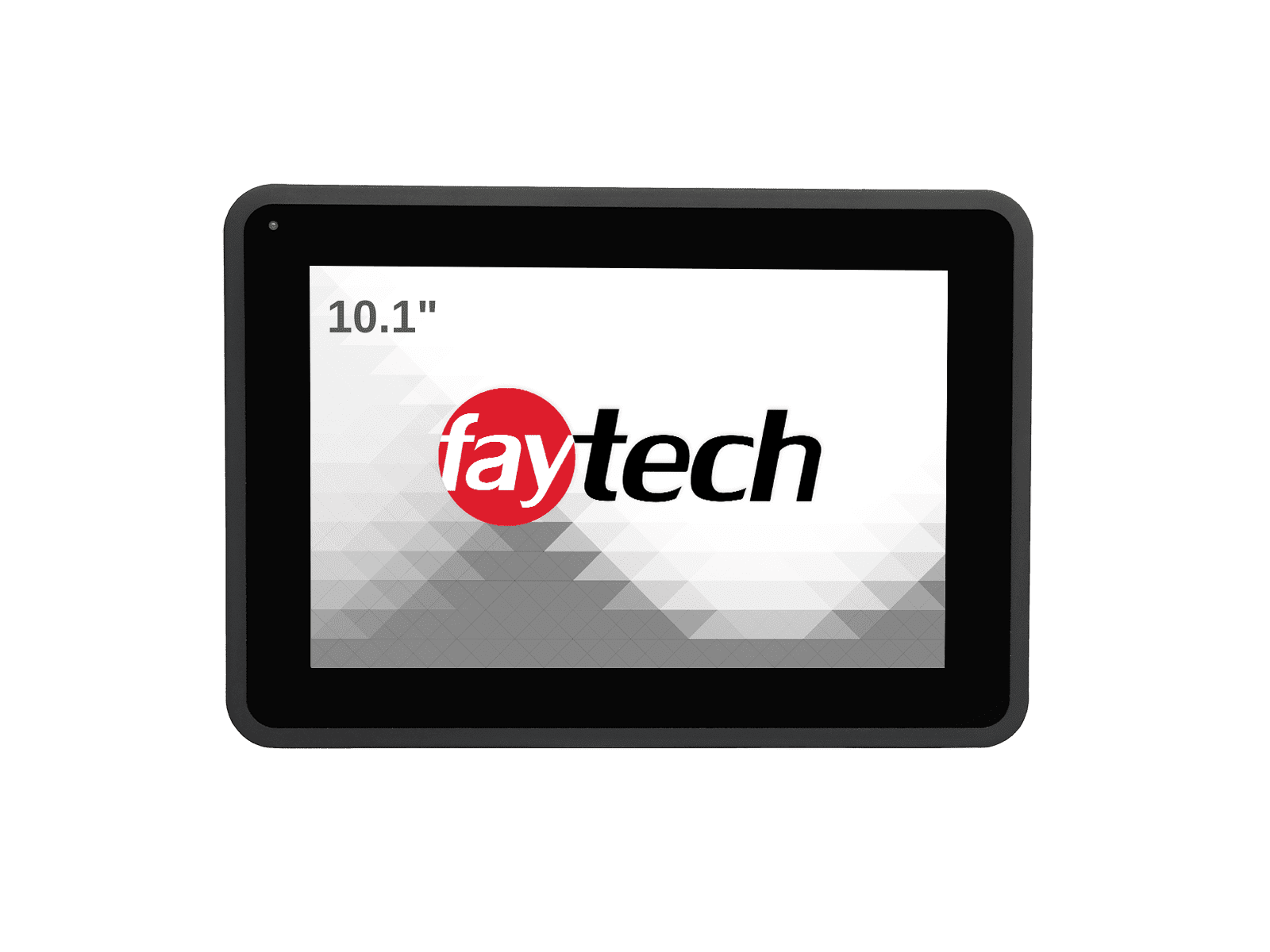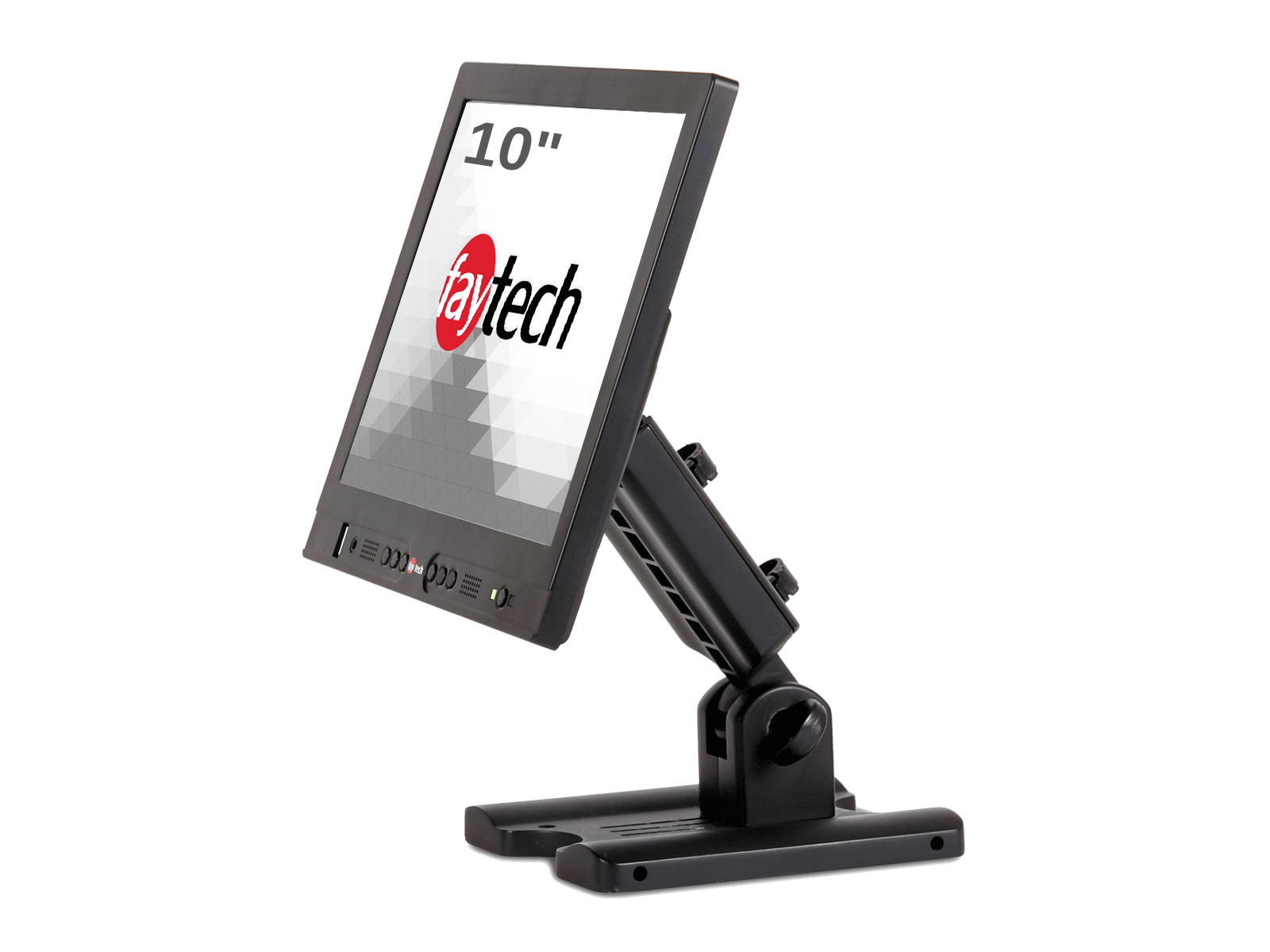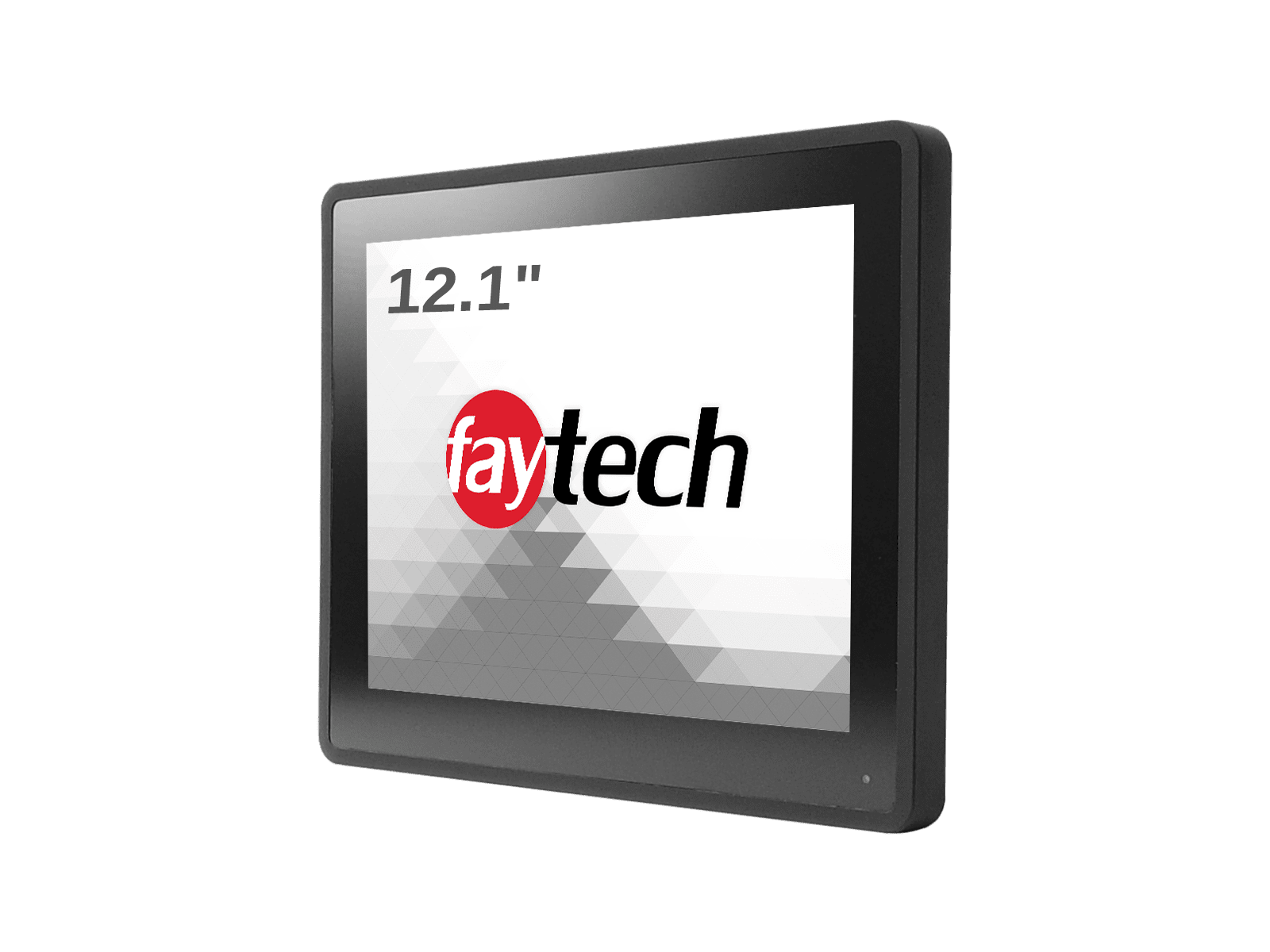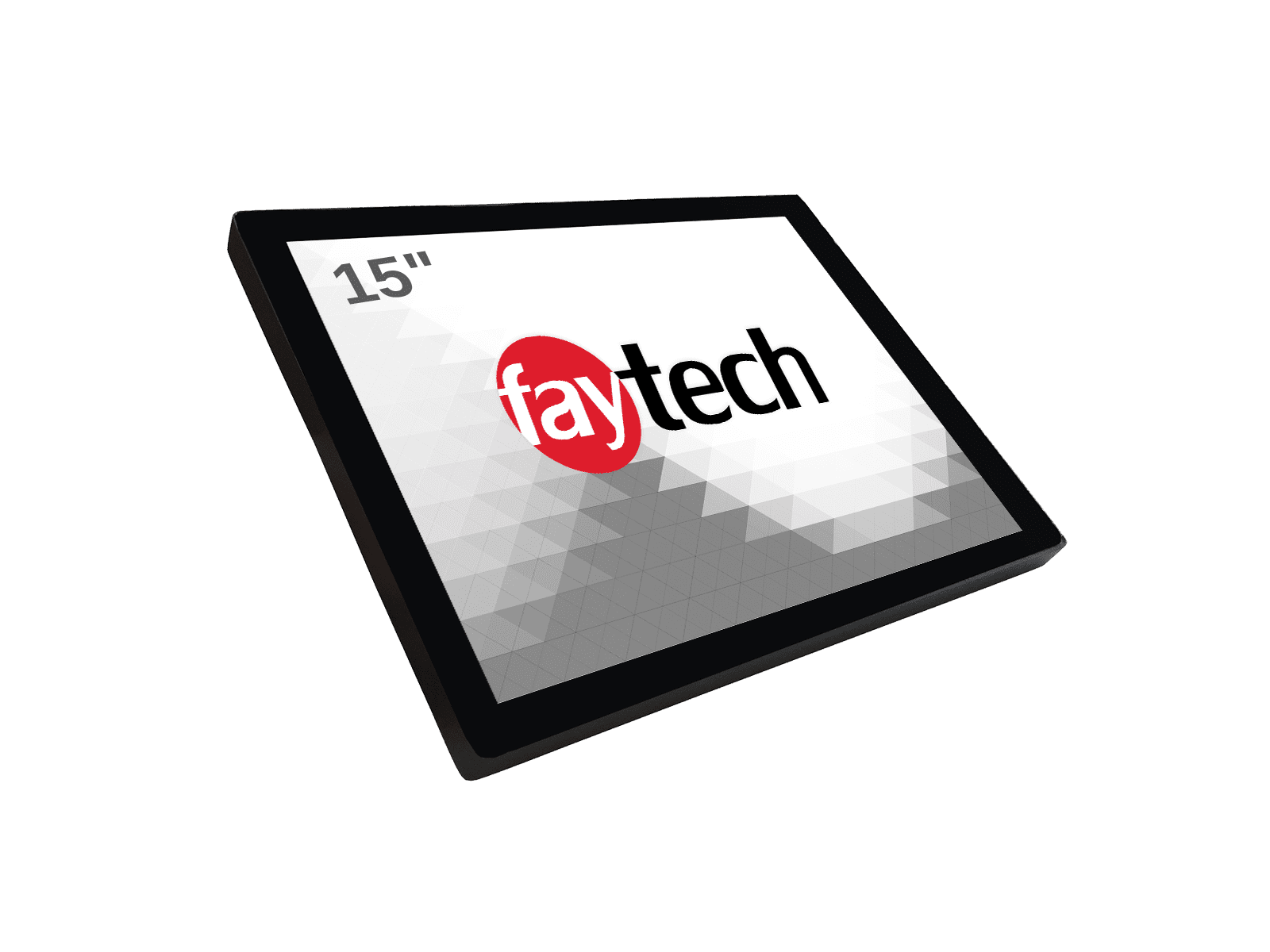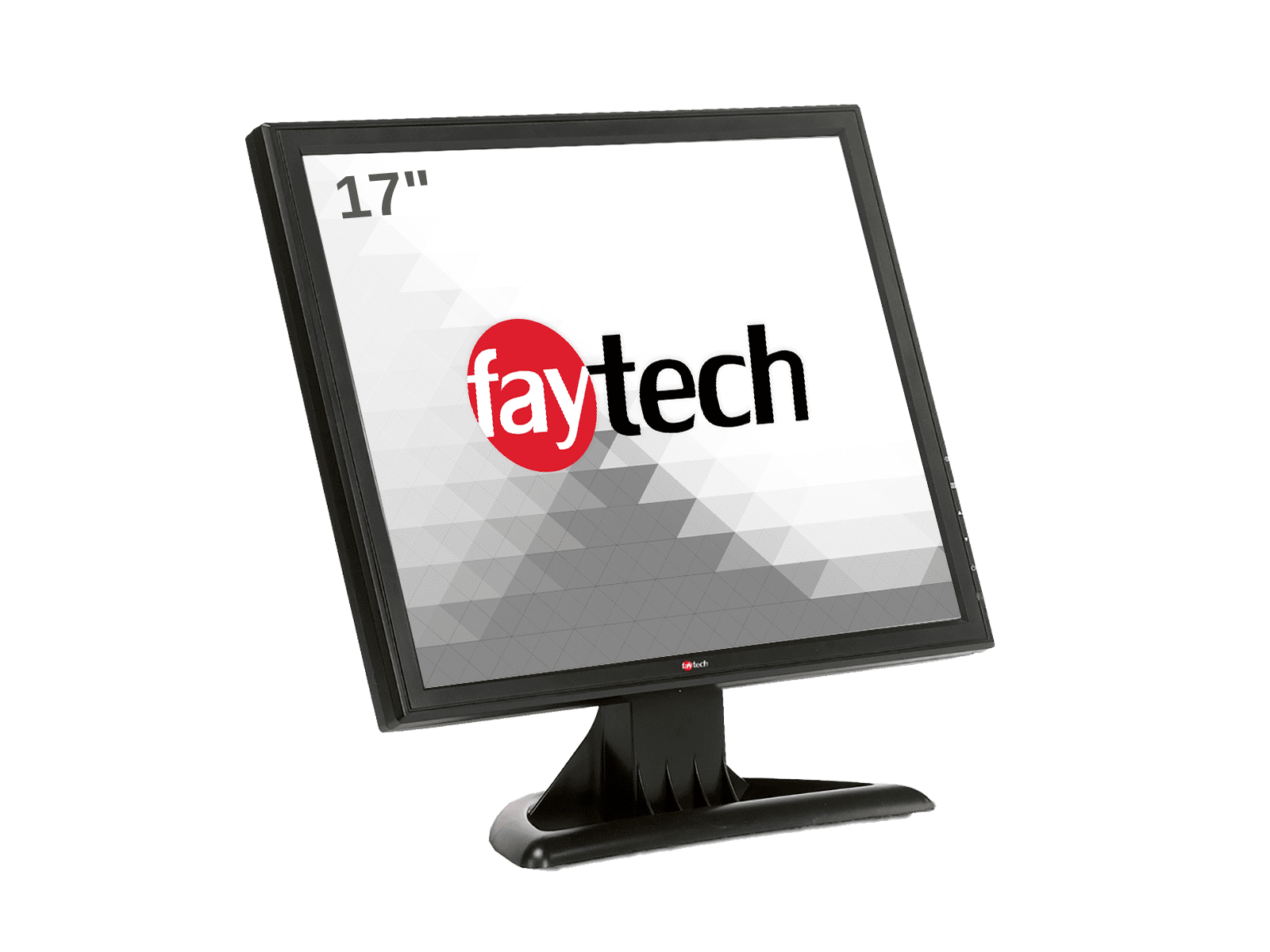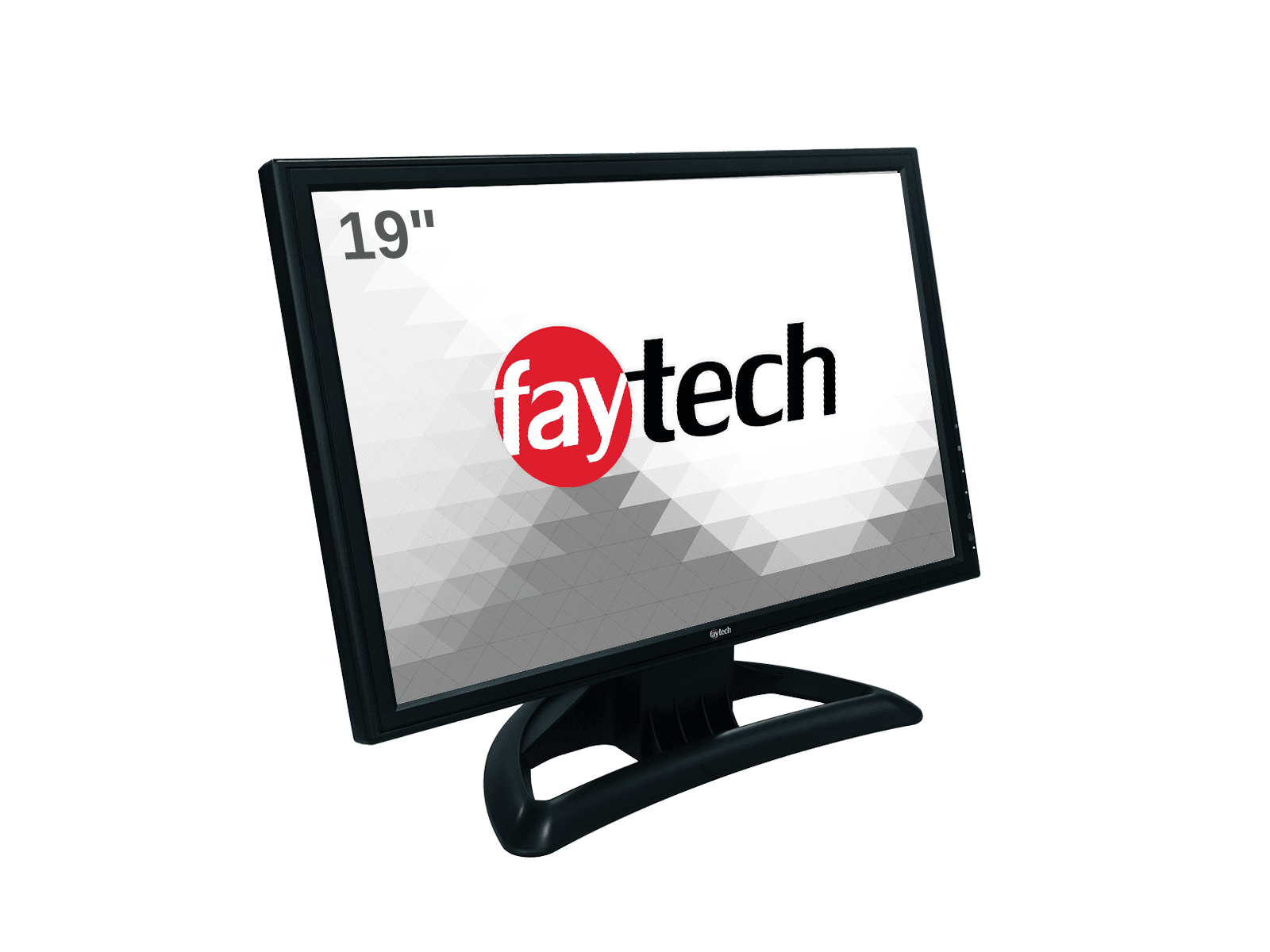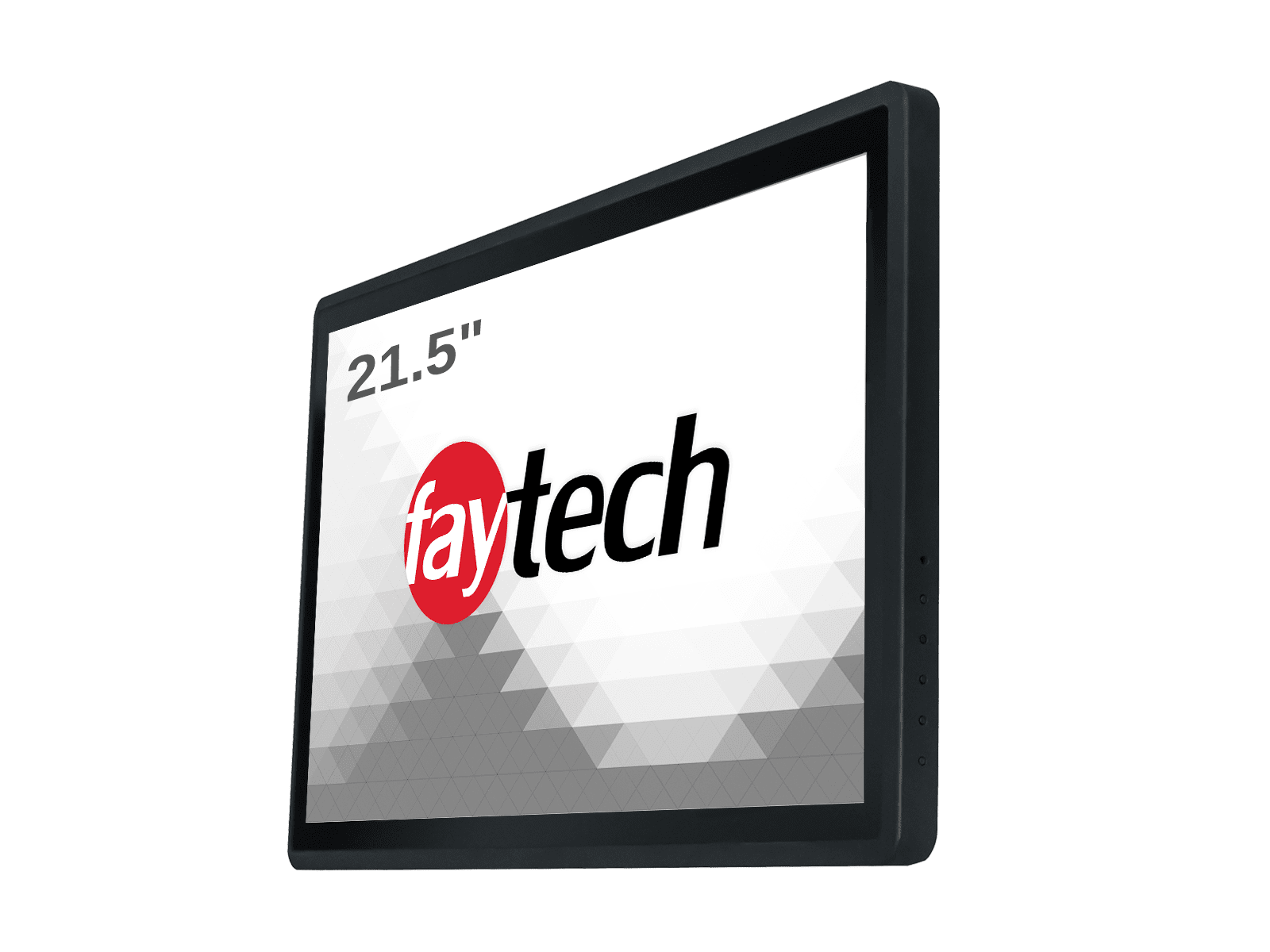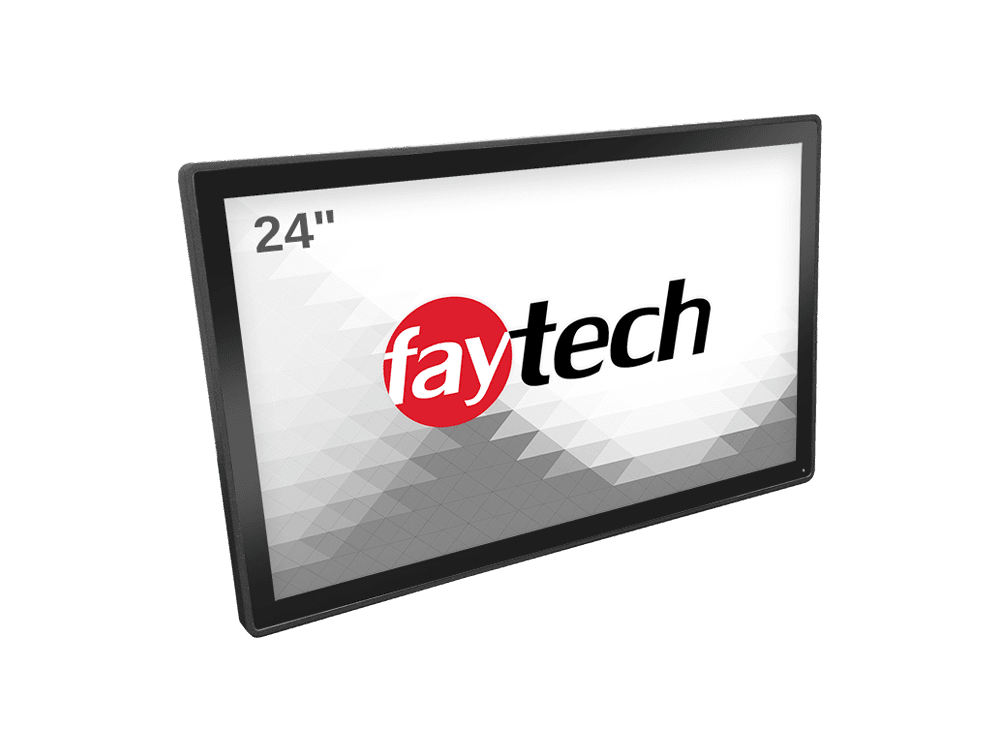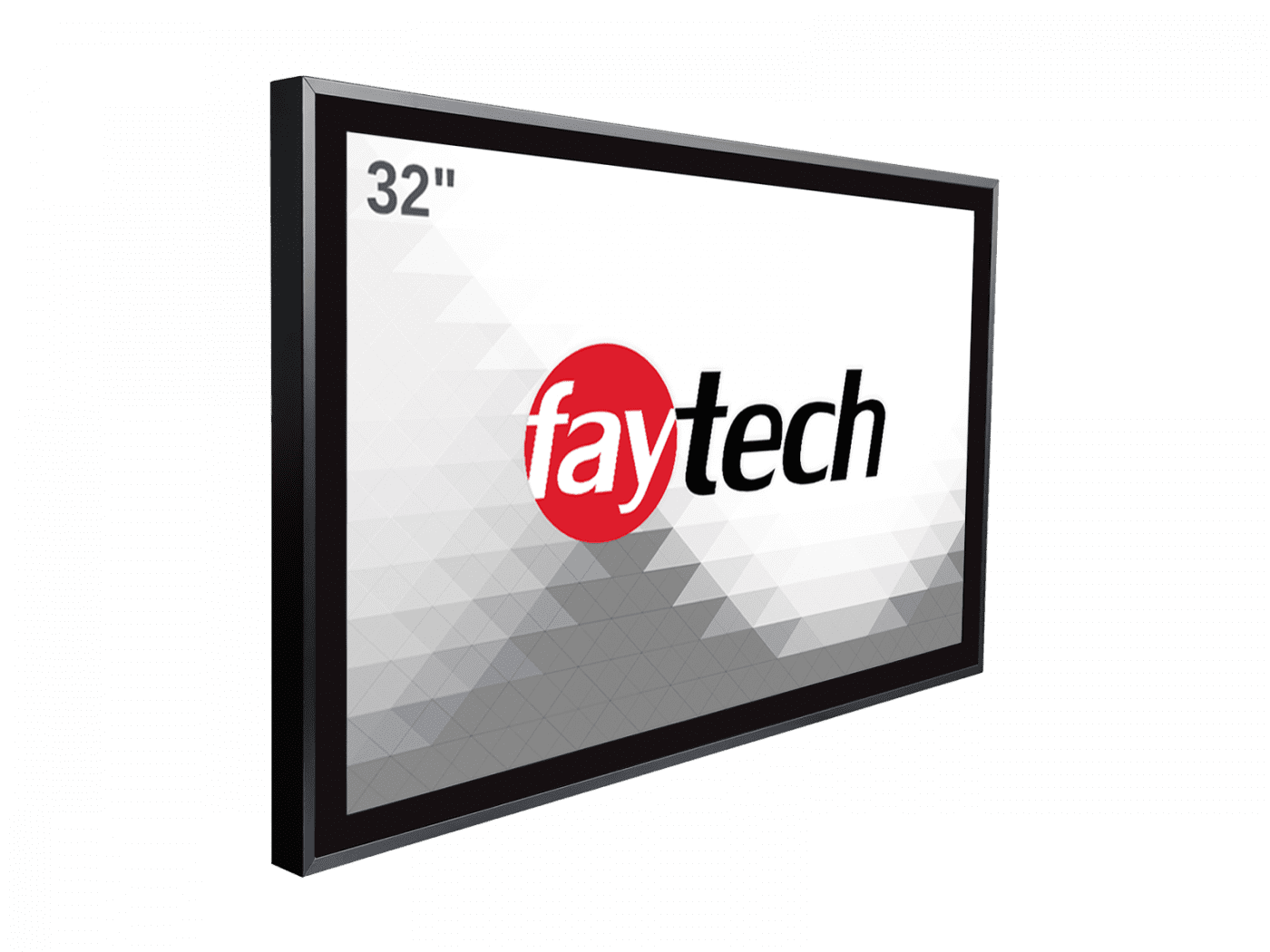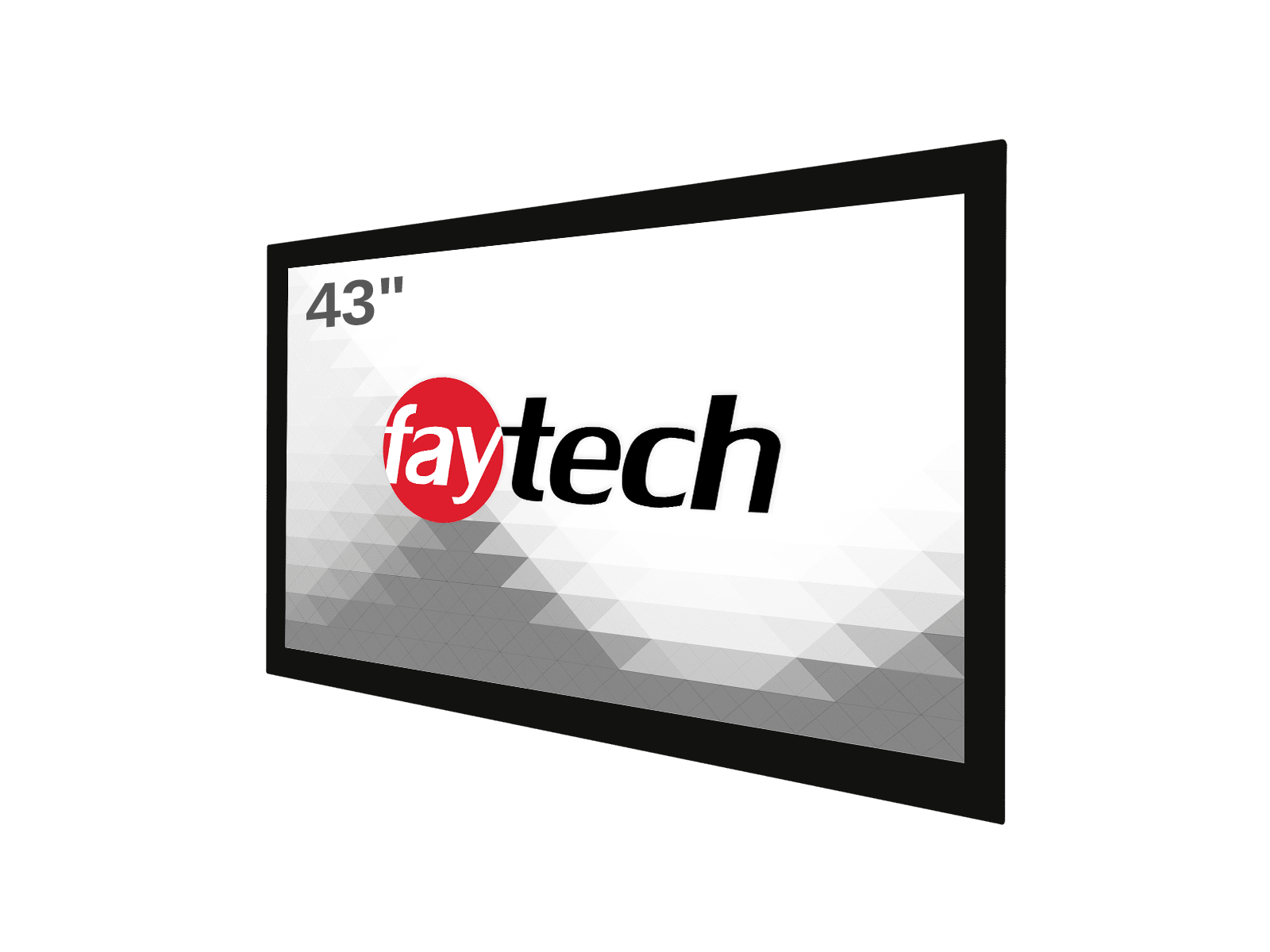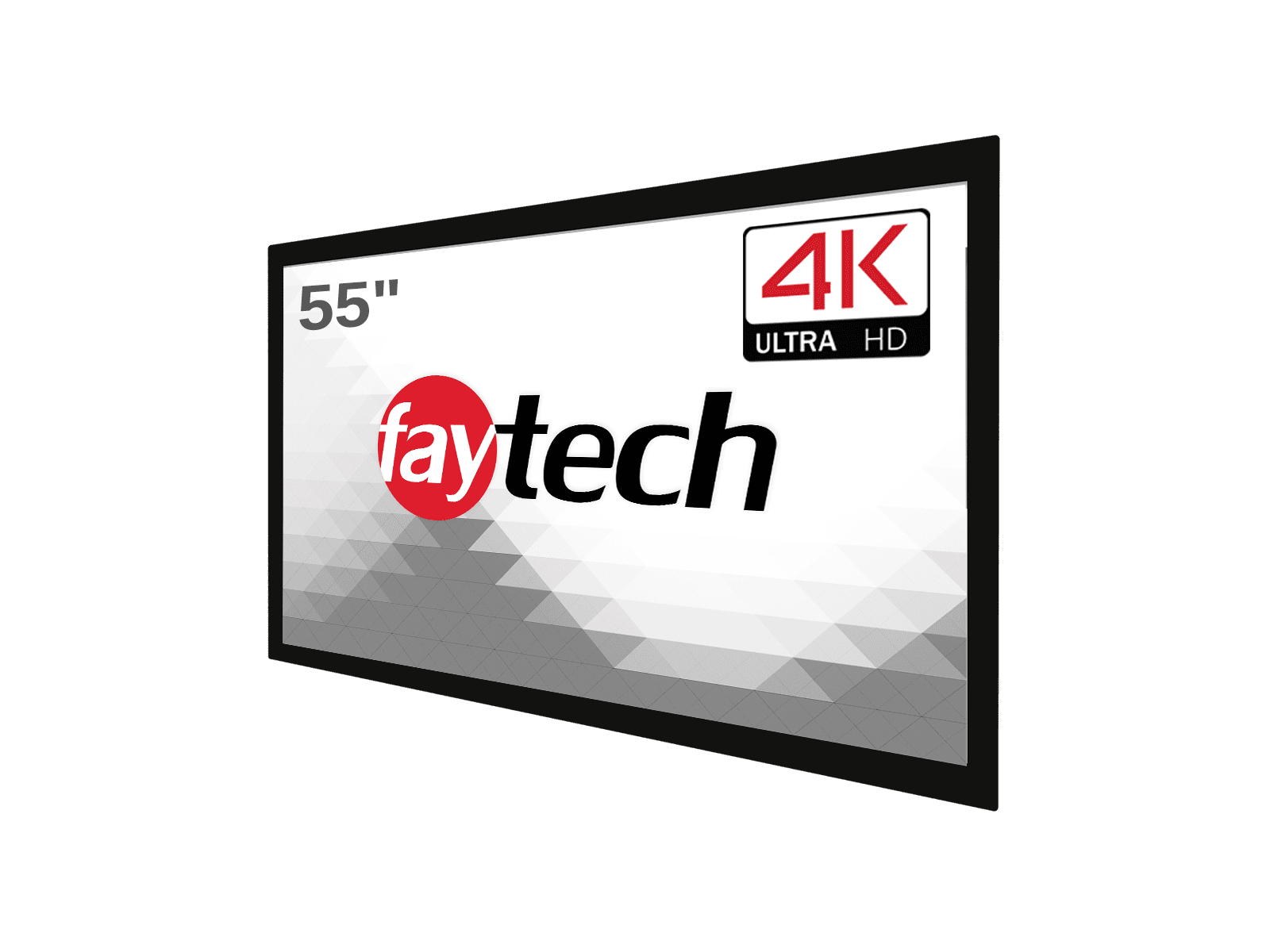Touch Screen Monitors for Sale
faytech North America
Capacitive Touch Screen Monitors
These are perfect for indoor commercial and industrial applications such as point of sale, retail advertising/signage, office, and industrial machine interfaces.
High Brightness Touch Monitors
This lineup is ideal for outdoor and semi-outdoor applications such as outdoor advertising and information systems, restaurant menus, and outdoor industrial control systems.
Resistive Touch Screen Monitors
These are excellent alternative options to PCAP for POS systems, control panel interfaces in industrial facilities, kiosk input interfaces, machine interfaces, and in numerous other commercial and industrial applications.
Open Frame Touch Screen Monitors
Perfect for indoor commercial and industrial applications that need to be integrated into custom designs for usage in point of sale, retail advertising/signage, office, and industrial machine interfaces.
Explore Our Touchscreen Display Solutions
One of the many challenges facing businesses today is how to select touch screen monitors. Many different applications have very different demands. Specific technologies or functionalities that might be beneficial in one industry, might be harmful in another.
Many possible suppliers offer solutions that might work, but fail to offer enough information about those products to allow for a truly informed decision to be made. faytech solves these issues by offering a comprehensive catalogue of touch monitor products from 7” through 55”, with a clear choice to suit any application.
Additionally, our sales team is always available to help answer any and all touch monitor questions.
More Information
All faytech touch screen monitors are truly industrial grade, with optically bonded touch panels and with minimum operational temperature ranges of -20°C to 70°C.
All faytech touchscreen monitors come with standard display input ports, USB touch output port, and DC power cable. All faytech touchscreen monitor solutions feature LCD displays with LED backlight units.
Our Touch Screen Monitor Products
Technical specifications and drawings are available to download for all of our standard touchscreen monitor modules. Our touch screen monitor lineup is divided into three major categories:
- Our Capacitive Touch Monitors, Open Frame Touch Monitors line features options from 7” to 55” with apertures for standard mounting brackets. These touchscreen monitor solutions are perfect for indoor commercial and industrial applications such as point of sale, retail advertising/signage, office, and industrial machine interfaces.
- The Resistive Touch Monitor series ranges from 7” to 22” and are stand-up touchscreen monitor solutions. These touchscreen monitors are excellent alternative options to PCAP for POS systems, control panel interfaces in industrial facilities, kiosk input interfaces, machine interfaces, and in numerous other commercial and industrial applications.
- Faytech’s High Brightness Touch Monitors, Sunlight Readable Touch Monitors range from 8” to 55” and are specially designed for the most rugged outdoor environments. These feature IP65 sealing, rugged metal framing, and 1,000cd/m2 brightness LCDs along with PCAP touch panels. This touchscreen monitor lineup is ideal for outdoor and semi-outdoor applications such as outdoor advertising and information systems, restaurant menus, and outdoor industrial control systems.
- Faytech recognizes that many customers need more than just a touchscreen monitor. We also offer a full lineup of touch PCs which include all the best features of our industrial touch screen monitors, rugged touch monitors, portable touchscreen monitor along with integrated industrial computers with installed choice of OS. Just add software. If you’re looking to build a kiosk, we offer those as complete units too with a touch screen monitor.
- Even though we offer a very comprehensive portfolio of touch monitor products, sometime special requirements require special products. If you have a custom need – maybe a specific touchscreen display picked out, a custom form factor, or something larger than our standard line supports, we may still be able to help.
Please let us know your custom product needs and we’ll be happy to contact you.
More businesses are using touch screen monitors
One of the most obvious reasons is that touch screen monitors are extremely user-friendly. They are easy to use and provide a great user experience.
Additionally, touch screen monitors are very versatile. They can be used for a variety of purposes, such as customer check-in, product ordering, and employee time tracking.
Durable touchscreen monitors cost less.
Another reason why touchscreen monitors are becoming more popular in commercial and industrial settings is that they are very durable. A touch screen monitor can withstand a lot of wear and tear, which is ideal for businesses that have high traffic areas.
Additionally, touch screen monitors are very easy to clean, which is important for businesses that need to maintain a clean and sanitary environment.
Overall, touch screen monitors are becoming more popular in commercial and industrial settings because they are user-friendly, versatile, and durable.
If you are considering adding touch screen monitors to your organization, contact us today to learn more about your options.
We can bring you up to speed in no time and help you make the best touchscreen monitor choice for your specific needs.
The benefits of using touch screen monitors
Second, a touchscreen monitors are very durable and can withstand a lot of wear and tear. This makes a touchscreen display ideal for use in retail, governmental or commercial settings where they will be used frequently or in high traffic areas.
Finally, touchscreen monitors offer a great deal of flexibility and can be used in a variety of ways. For example, a touch screen monitor can be used for point-of-sale systems, self-service kiosks, or even as digital signage with optimal image quality.
Commercial Grade Touch Screen Displays Are Interactive and Engaging
Touch screen monitors are becoming increasingly popular in commercial and industrial businesses for both customers and employees.
There are several reasons for this trend of touch screen devices growing in popularity. Touchscreen monitors are interactive and engaging, making them ideal for businesses that want to encourage customer interaction.
A touch screen monitor is also easy to use, which makes them ideal for businesses that want to streamline employee workflow. In addition, touch screen displays are durable and can withstand heavy use, making them ideal for businesses that have high traffic areas.
They’re easy to use
There are many reasons why commercial and industrial businesses are starting to use touch screen monitors. They’re easy to use, they’re efficient, they have high image quality, and they offer a great user experience.
Touch screen monitors are easy to use because they don’t require any special training or knowledge to operate. They’re also very efficient because they can be used to process transactions quickly and accurately. And finally, they offer a great user experience because they’re interactive and user-friendly.
They’re versatile
Many types of organizations are starting to use touch screen monitors for customers and employees because they are versatile and easy to use. A touch screen monitor can help businesses save time and money.
Touch screen monitors are becoming increasingly popular in the business world because they offer a number of advantages over a traditional desktop monitor or 1080p monitor.
A touch monitor with a led backlit display is very versatile and can be used for a variety of purposes, such as customer service, order taking, and inventory management. A touch screen monitor is also very easy to use because of their HD res inputs and tilt angle high screen resolution with image quality that reduces eye strain.
Touch screen monitors are a great way to engage customers and employees, and they offer a lot of versatility for businesses.
There’s no doubt that touchscreen monitor developments have come a long way in recent years. We’ve seen touchscreen monitor technology become thinner, lighter and more responsive, and now a touch screen monitor is an integral part of many people’s lives.
In light of recent developments in Meta and virtual reality developments, it’s clear that the future of touchscreen monitor technology is looking very exciting.
With Meta, users will be able to interact with their computer and touch screen monitor in a whole new way, and virtual reality will allow them to immerse themselves in their work like never before.
So, what does this all mean for the future of touchscreen monitors? Well, it’s safe to say that we can expect to experience some very exciting touch screen monitor developments in the years to come.
While there are many adaptations in the works regarding NFTs and other Web 3.0 related tech, you’ll want to follow faytech North America to stay up to date with where we take touchscreen monitor devices.
The Evolution of Touchscreen Monitor Science
The First Touchscreen Devices
Touchscreen monitor technology has come a long way in recent years, and the future looks even brighter. With the development of Meta and virtual reality, the potential for touchscreen monitors is even greater.
With these new touch screen monitor technologies, users will be able to interact with a touch screen monitor in ways that were not possible before. This will open up new possibilities for how we use touchscreen monitors in the future.
As touchscreen monitor products become more and more commonplace, it’s only natural to wonder what the future of touchscreen technology holds.
With the recent developments in meta and virtual reality, it’s difficult to say for sure. However, it’s safe to say that touchscreen technology will only become more advanced and widespread in the years to come.
Touch Technologies that will revolutionize your industry
faytech offers 2 major touch screen monitor technologies in its standard touch monitor catalogue – Projected capacitive (PCAP) touch and Resistive touch.
Projected Capacitive
(PCAP) touch technology was invented in the 1980’s. Devices featuring projected capacitive touch screen monitor first started to appear in the late 1990’s, but none truly gained real popularity during that time. The first device to truly popularize PCAP technology was the iPhone in 2007. The proliferation of the smart phone over the next 5 years made PCAP the consumer touch technology.
Today, PCAP makes up over 97% of all display touch panels worldwide. This scale of adoption has pushed the cost of PCAP technology to be very close to that of 4-wire resistive touch, and much cheaper than other forms of resistive touch.
Nearly all consumer-facing touch screen devices and touch screen monitor devices (phones, laptops, tablets, casino games, automobiles, retail kiosks) have adopted the technology exclusively.
Non-consumer industrial touch screen applications also tend to prefer PCAP due to the strength afforded by its front glass surface and superior optical clarity.
Recent advances in PCAP technology are allowing it to continue to gain market share in several of the areas still occupied by resistive technology.
- Newer PCAP touch screen panels can be successfully tuned to allow functionality for even the heaviest cloth or leather gloves.
- The latest generations of PCAP touch panels also feature the ability to detect a liquid spills, sprays, or even heavy rain and not falsely activate.
- The latest generations of PCAP touch screen panels also feature the ability to detect the palm of a hand on the screen and not falsely activate.
PCAP touch screens are essentially a grid of transparent capacitors typically spaced 5-12mm apart throughout the touch surface. The technology works by detecting changes in the electric field at each capacitor ‘node’ when a conductive object touches the front surface of the device. The touch controller accepts reports of the capacitance at each node every few milliseconds – if any node has a capacitance past a programmed threshold, a touch is registered.
The conductive films do not need force or motion to function, so the front surface can be a strong glass (anywhere from 0.4mm to 6mm thick), or even plastic material. For this reason, PCAP touch devices are the most rugged of all current touch technologies, and do not have the ‘overuse failure’ mechanism of 4-wire resistive touch.
They are extremely popular, in part, due to the multi-touch and gesture controls (drag, flick, pinch) afforded by the technology that open up great interactivity options for end-use applications.
Since there are no moving parts in a PCAP touch, the layers are always optically bonded, which gives PCAP a better overall look than resistive, with significantly better contrast and higher brightness.
However, PCAP touch screens only function when touched by a conductive material, such as a finger or capacitive stylus. Some PCAP touch devices can have issues with liquid spills registering as touches, or heavy gloved fingers failing to trigger a touch (though current-gen industrial devices have mostly solved these problems). faytech industrial PCAP devices have been designed for, and tested with, heavy rain and thick glove environments.
Most Common Applications for PCAP technology:
- Consumer electronics: Nearly all cell phones, tablets, and laptops use PCAP touch technology. Consumers are used to precise multi-touch gesture controls and not needing to put pressure on the screen to register a touch. Additionally, they are also used to the smooth surface and clean look provided by a front glass.
- Gaming: Players at casinos using a touch screen prefer PCAP, since it is what they are generally used to on every other device they own. The front screen is protected by a thick front glass. Units can be protected from spills, and drink glasses on the touch surface won’t inadvertently activate the touch.
- Advertising: Public-facing touch screens should be easily accessible by the public. People are used to having PCAP touch screens in their pockets at all times, and using PCAP here provides a consistency of experience. Thick glass surfaces can additionally protect the underlying display from damage.
- Outdoor: Since resistive touch always needs to include an air gap, it is not generally good, optically speaking, for usage in high ambient light environments. Optically bonded PCAP units preserve display contrast in outdoor situations, allowing units with lower brightness (and lower power consumption) to still be visible.
- Automotive: The look and features of the center information display have become a key selling point for automotive OEMs. Ultimately, this display is a consumer device. Drivers expect the same experiences they have at home on their phones and tablets. For automotive designers, the display systems themselves have requirements similar to rugged industrial uses in order to promote safety, visibility, and reliability of the display. PCAP technology provides the familiarity, optical superiority, and reliability to meet these requirements.
Resistive touch technology origins
Resistive touch technology was invented in 1970. The technology was popularized through the 1980’s and 90’s in applications such as credit card readers with signature pens, touch interfaces for office printers, and PDAs. While resistive touch is no-longer the most common (now only around 2% of total touch panel market), there are still applications where it is the best option.
Resistive touch screens function by having 2 ITO layers separated by air and spacers. When a force causes the 2 ITO layers to touch, a circuit is completed and the location of the touch is reported. Due to the nature of the technology, just about any object can be used to touch the screen (gloved hands, long fingernails, credit cards, pens).
Resistive touch technology is also great in scenarios where spills or dirt is expected to end up on the touch surface – unless the weight is enough to push the film against the underlying glass, touch functionality will remain. Since it requires some small amount of force for a touch to register, it is less likely than other technologies for a user to inadvertently register a touch on the screen.
However, resistive touch screens are less optically clear than competing technologies due to the 2 layers being separated by air, which increases reflectivity. Lower cost 4-wire resistive touch screens are typically prone to failure after around 200,000 touches, though more rugged 5-wire versions are available which alleviate this issue (faytech offers both).
Typically, the top layer of a resistive touch panel is a thin PET film with ITO rear coating, which limits how rugged these units can be made (though some smaller units can be made with a thin glass front surface). Resistive touch screens do very well with single point touch, but tend to suffer in applications where multi-point and gesture touch controls are required.
Most common applications for resistive touch technology:
- POS Systems: Retail employees like being able to use non-conductive objects to tap on-screen buttons – pens, credit cards, long fingernails. These will work with resistive touch screens, but not with capacitive touch. Card readers frequently also come with resistive touch panels for accepting customer signatures.
- Cockpit Avionics: Resistive touch panels do not rely on an electric field outside the touch panel surface to operate. Since electromagnetic noise in the cockpit of a certified aircraft must be tightly controlled, resistive touch is still a common technology. Additionally, resistive screens require some small amount of force to register a touch, making pilot errors less likely during turbulent flight.
- Gloved Touch: Many applications where thick gloves are worn by operators are still including resistive touch. While capacitive technology has come a long way in allowing heavy glove touch, resistive touch still provides a surety that all gloved touches will register.
Optical Bonding Technology
What many suppliers view as an upgrade, faytech views as a standard. We believe strongly in the benefits of direct bonding and believe it should be included in all touch products – and so it is in all of our products.
- Optically bonded products sold by faytech improve the contrast of the image on the screen. This gives the image on the screen, as well as the display system itself, a crisp, professional look. It is greatly beneficial in outdoor and semi-outdoor environments.
- Optically bonded touch displays are brighter than those with cheap air-gap construction.
- Impact Resistance. Optically bonded displays can survive much greater impacts than unbounded displays. This is truly a must-have for any public-facing display unit.
- faytech optically bonded displays have a layer of clear silicone gel between the touch panel and LCD front glass. This layer blocks dirt, dust, and moisture from getting behind the glass. This ensures that your faytech display will be visible in the harshest environments.
Touch screen monitors were initially used in point-of-sale (POS) terminals, kiosk systems, ATM’s and on PDA’s. The ever-expanding popularity of smartphones using Android and iOS operating systems, tablets, GPS systems and gaming consoles are increasing the demand for touch screen technologies.
The evolution of interactive touch displays for commercial applications
Early touchscreen displays could only sense a single point of input at a time and only a few of them were capable of detecting the strength of the pressure. This was changed with Apple’s ongoing commercialization of the multi-touch technology with iPhone and iPod touch.
Multi-touch touch screen technology allows the user to interact with the screen with fingers, instead of a stylus. The movement of fingers creates gestures, which are then sent to the software. The initial popularity of the iPhone, has brought touch technology to many smart phones and hand-held devices which paved the way for all-in-one computer systems.
Many companies are upgrading to touch monitors
Faytech North America, as a touch screen manufacturer has realized that many companies have upgraded their products, either by adding multi-touch support to the track-pad or by making their tablet PC’s interactable without using a stylus. Both wall mounted and table mounted options have few ergonomic problems. “gorilla arm” was a side effect, that has limited wall-mounted option as a mainstream.
Developers of touch systems, failed to notice, that humans are not designed to hold their arms extended for long periods of time while making small and precise motions.
Table embedded displays do not share this problem, however, users can develop neck pain after using it for a period of time and the view might be obstructed by their arms.
High adoption of touch systems in the retail sector
Ever since their development in 1971, touchscreen monitors have been finding their way into more and more commercial applications. They come in any number of configurations, but in the end, they all function on the same principle and that is “see and touch”.
Fast food restaurants were one of the first businesses to implement these screens on a retail level but now more and more business are discovering the benefit of having them available at their point of sale locations.
How touch screen monitors work
There are three commonly used types of touchscreen monitor technologies: resistive, capacitive, and surface acoustic wave (SAW):
Resistive touchscreen solutions
The resistive touch screen type uses a normal glass panel, that is covered by a resistive and a conductive metallic layer and a protective layer (scratch resistant) on top of all this. When you make contact with the screen, the two metallic layers are joined and the change in electrical field is detected. The circuit on the display then calculates the coordinates and transfer them to the screen software. The driver then transfers the information about the coordinates to the OS, in a form of events similar to mouse clicks and drags.
This system registers an event as soon the surfaces are joined. This means, you can use a finger, a pen or any other item as input.This also makes it most vulnerable to physical damage by sharp objects. The metallic layers only transmit about 75% of the light, making its display clarity the lowest of the three.
Capacitive touch screen
With the capacitive touch screen type, a layer storing electrical charge, is placed on the glass. When you make contact with the layer, a small amount of the electrical charge is transferred to you, decreasing the charge on the layer. Sensors, located at the corners of the screen, detect a change in electrical charge levels and transfer the information to the software to process.
Capacitive vs resistive screen technology
The biggest advantage of capacitive type over resistive is that it has 90% light throughput. This gives the capacitive touch screen monitors a much clearer picture. Since this type of technology uses electric charge to detect an event, you must use a conductive input, such as a finger.
Surface acoustic wave type screens
The surface acoustic wave type uses two transducers and a reflector, all placed on the glass plate. One transducer is sending electrical signals to the other and the reflector reflects this signal. The receiving transducer is capable of detecting and locating any event.
Since this type has no metallic layers placed on the display surface, they have 100% light throughput, and therefore the most clear picture. Similar to resistive, this type detects events by almost any object, except very small or hard items, such as a pen.
These are just the most commonly used touch screen types and we at faytech North America have our own unique touch solutions. There are many other touchscreen technologies out there, such as strain gauge configuration (from 1960’s) or relatively-modern optical imaging technology. And recently, new touchscreen monitor technologies have been developed such as sunlight readable monitors, rugged monitors and open frame touch screen monitors that can withstand extreme environments.
Benefits of using touchscreen monitors
Touch screen displays are very easy to figure out and most people will learn how to interact with them very quickly. The learning curve is very short. A recently hired employee no longer has to go through lengthy training sessions and can be found effortlessly using an intuitive touch interface within a few hours.
Time Savings
The touch screen technology developed by faytech North America brings significant time savings to point of sale systems in any retail establishment. The touch solutions simplify most transactions. The employee – or the customer – interacts with the screen, reviewing the potential options and makes a selection.
No bar coding required
Products that cannot be bar coded, like perishable items, for example, or things that are small or with irregular surfaces that would hinder barcoding can now be easily processed through a point of sale with a touch screen display.
Less manpower
Also, using touch screen interface means that customers can make buying decisions without the help of employees.
The viability as an interaction tool for the retail establishment has been established for some time now and this is why more and more businesses everywhere are implementing touch screen technologies.
Affordable
Another factor is that faytech North America touch screen displays have also become more affordable in recent years and they are a technology that isn’t going to become obsolete in this lifetime.
Contact faytech North America for all your questions.
OUR OFFICES
NEW YORK
239 West 29th Street
Ground Floor
New York, New York 10001
FLORIDA
7630 NW 25th ST
Suite 2A
Miami, FL 33122
CALIFORNIA
804 Anacapa Street
Santa Barbara, CA 93101
+1 646 843 0877
sales@www.faytech.us
Latest Articles
- 12 Reasons to Upgrade to Commercial Grade Touch Displays
- A Brief History of the Touchscreen Monitor
- Touch Software Allows You To Control a PC Like a Smartphone
- How Does Touch Technology Work on Computers?
- The Differences Between Capacitive, Resistive, Industrial and IP65
- Why Using a Large Touchscreens is Essential in Your Industry

